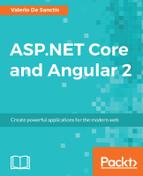ASP.NET Core MVC is a web framework, built on top of the core .NET framework, specifically made for building efficient web applications and APIs that will be able to be reached by a massive range of clients including web browsers, mobile devices, smart TVs, web-based home automation tools, and more.
Angular 2 is the second major installment of AngularJS, a world-renowned development framework born with the idea of giving the coder the toolbox needed to build reactive, cross-platform web-based apps, which are optimized for desktop and mobile: it features a structure-rich templating approach which is based upon a natural, easy-to-write, and readable syntax.
These two frameworks were put together with the same assumption in mind: the HTTP protocol is not limited to serving web pages, it can be also used as a viable platform to build web-based APIs to effectively send and receive data. This theory has slowly made its way through the first 20 years of the World Wide Web and is now an undeniable, widely acknowledged statement, and also a fundamental pillar of almost every modern web development approach.
As for the reasons behind this perspective switch, there are plenty of good reasons for it, the most important of them being related to the intrinsic characteristics of the HTTP protocol. It is simple to use, flexible enough to match most development needs in the always-changing environment which the World Wide Web happens to be, not to mention how universal it has become nowadays, almost any platform that you can think of has an HTTP library, so HTTP services can reach a broad range of clients, including browsers, mobile devices, and traditional desktop applications.
From the perspective of a fully-functional web-based application, we could say that the Web API interface provided with the ASP.NET Core framework is a programmatic set of server-side handlers used by the server to expose a number of hooks and/or endpoints to a defined request-response message system, typically expressed in structured markup languages such as JSON or XML. This "exposition" is provided using the HTTP protocol thanks to a publicly available web server (typically IIS). Similarly, Angular can be described as a modern, feature-rich client-side library that gives the browser the ability to bind input and/or output parts of an HTML web page to a flexible, reusable, and easily testable JavaScript model.
These assumptions allow us to answer a simple, yet inevitable question: can we put together the server-side strengths of ASP.NET Core's Web API capabilities with the frontend capabilities of the Angular library in order to build a modern, feature-rich, and production-ready web application?
The answer, in short, is yes. In the following chapters, we'll see how we can do that by analyzing all the fundamental aspects of a well-written, properly designed web-based product and how ASP.NET Core and/or Angular can be used to handle each one of them.
The new major version of Angular is a complete rewrite of the previous one, entirely based upon TypeScript and ECMAScript 6 specifications. The choice of not making it backward compatible with the previous installment clearly demonstrates the intention of the authors to adopt a completely new approach, any developer who already knows AngularJS will undoubtedly face a huge number of breaking changes, not only in the code syntax but also in the way of thinking and designing your client app. Angular 2 is highly modular, entirely component-based, features a new and improved dependency injection model and has the main goal of being able to easily integrate with other server-side and client-side frameworks.
However, the most important reason why we're picking Angular 2 over other excellent JS libraries such as ReactJS and EmberJS is the fact that it arrives with a huge stack of features out of the box, making it way simpler to use than the aforementioned competitors. If we combine that with the consistency given by TypeScript language we could very well say that, despite being the youngster, Angular 2 has embraced the framework approach more convincingly than the others. That's a great reason to invest in it, hoping it will keep up with these compelling promises.
Summarizing what has happened in the ASP.NET world within the last year is not an easy task, in short, we could say that we're undoubtedly facing the most important series of changes in the .NET Framework since the year it came to life. ASP.NET Core is a complete re-implementation of ASP.NET, which unites all the previous web application technologies such as MVC, Web API and Web Pages into a single programming module, formerly known as MVC6. The new framework introduces a fully featured cross-platform component, also known as .NET Core, shipped with a brand new open source .NET Compiler Platform (currently known as Roslyn), a cross-platform runtime (known as CoreCLR), and an improved x64 Just-In-Time compiler (RyuJIT).
Note
You might be wondering what happened to ASP.NET 5 and Web API 2, as these used to be quite popular names until mid-2016.
ASP.NET 5 was the original name of ASP.NET Core, before the developers chose to rename it to emphasize the fact that it is a complete rewrite. The reasons for that, together with the Microsoft vision about the new product, are further explained in the following blog post from Scott Hanselman that anticipated the changes on January 16, 2016:
http://www.hanselman.com/blog/ASPNET5IsDeadIntroducingASPNETCore10AndNETCore10.aspx
For those who don't know, Scott Hanselman has been the outreach and community manager for .NET/ASP.NET/IIS/Azure and Visual Studio since 2007.
Additional information regarding the perspective switch is also available in the following article by the senior Microsoft developer (and NuGet Program Manager) Jeffrey T. Fritz: https://blogs.msdn.microsoft.com/webdev/2016/02/01/an-update-on-asp-net-core-and-net-core/
As for Web API 2, it was a dedicated framework for building HTTP services returning pure JSON or XML data instead of web pages. Initially born as an alternative to the MVC platform, it has been merged with the latter into the new, general-purpose web application framework known as MVC6, which is now shipped as a separate module of ASP.NET Core.
